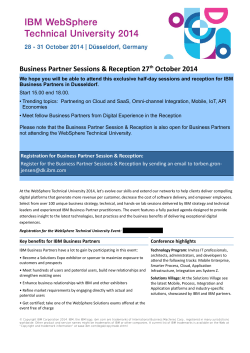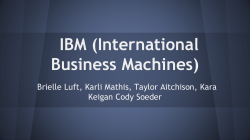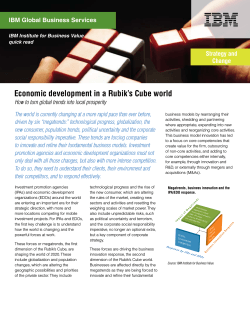
IBM Security Access Manager Appliance Networking Version 1.5
IBM Security Systems IBM Security Access Manager Appliance Networking Version 1.5 Martin Schmidt, Nick Lloyd, Gabe Bell, David Shen, Patrick R Wardrop IBM Security Systems November 2014 © 2014 IBM Corporation 1 © 2013 IBM Corporation IBM Security Systems Note: Before using this information and the product it supports, read the information in "Notices." Edition notice This edition applies to version 8.0.0.5 or newer of IBM Security Access Manager and to all subsequent releases and modifications until otherwise indicated in new editions. © Copyright International Business Machines Corporation 2014. Note to U.S. Government Users Restricted Rights -- Use, duplication or disclosure restricted by GSA ADP Schedule Contract with IBM Corp. 2 © 2014 IBM Corporation IBM Security Systems Overview ! This presentation introduces the reader to the IBM Security Access Manager Appliance networking. ! It reviews the networking at the appliance level, as well as how to integrate the appliance into the existing networking infrastructure. ! Unlike the previous software releases, the appliance (virtual or hardware editions) come with a total of 6 network interfaces. ! These interfaces play different roles and have to be configured accordingly. 3 © 2014 IBM Corporation IBM Security Systems Appliance Interfaces – Low Level Required P.1 eth2 P.2 eth3 Appliance M.1 eth0 Required M.2 eth1 Required P.3 eth4 P.4 eth5 The virtual appliance requires a minimum of 3 virtual network adapters defined but at a minimum only the P.1 for Proxy use cases and M.1 (all use cases) interfaces need to have IP addresses assigned. For failover cases or connections to multiple subnets, additional interfaces should be enabled and assigned IP Addresses. 4 © 2014 IBM Corporation IBM Security Systems Appliance Interfaces – Virtual M.1 M.2 Not connected P.1 This picture is showing a virtual appliance on a VMWare virtual device management panel. Notice that the second network adapter is defined but doesn’t have to be connected. 5 © 2014 IBM Corporation IBM Security Systems Appliance as a Policy Server Configured with IP M.1 eth0 P.1 eth2 P.2 eth3 P.3 eth4 Appliance as MGR (Policy Server) M.2 eth1 P.4 eth5 In the case of a virtual appliance, the last three virtual adapters are not defined. When using a physical appliance, the last 3 ports are optional and don’t need to be connected to the network. The configuration of M.2 is optional. 6 © 2014 IBM Corporation IBM Security Systems Appliance as a Reverse Proxy Configured with IP Configured with IP Configured with IP Configured with IP Configured with IP M.1 eth0 P.1 eth2 P.2 eth3 P.3 eth4 Appliance as PROXY (Reverse Proxy) M.2 eth1 P.4 eth5 In this case the last three network cards are optional and may be configured or not, depending on the architecture. A reverse proxy listens for connections on any of the P.x ports, and connects the traffic to a back end server via any interface based on the routing configuration. The proxy will listen for all interprocess communication between ISAM components (e.g., policy updates) via the M.x ports. 7 © 2014 IBM Corporation IBM Security Systems Appliance as All-In-One Firewall Firewall Application Application Application P.1 M.1 P.2 M.2 (failover) P.3 Appliance As All-In-One • • • • • • Backend Applications User Registries Monitoring (snmp) Email notifications Backup (Snapshot) Administration (LMI,CLI,REST) • Policy Distribution • Mobile Services • Internal LDAP • Authz Servers P.4 External 8 Internal © 2014 IBM Corporation IBM Security Systems Appliance as All-In-One - con’t In the case where the appliance is used as an All-In-One model, the appliance would reside in the DMZ, with the P1-P3 interfaces configured externally facing, and the M1-M2, and P4 as internal facing. NOTE: In such a setup, the appliance may bridge the internal firewall of the DMZ. The P.1 to P.3 interfaces servicing any application requests received from the internet. The M.1 and M.2 interfaces provide the internal facing connection, any application traffic to the back end servers are directed from these interfaces. Also the user registry, which would be on the internal network, is accessed via that interface. Any management or monitoring would be performed via these interfaces as well. The communication between the policy server and any proxy instances is taking place via these networks. The P.4 interface would also be configured as an internal facing IP, as it would expose services that are not directly accessed from the client, but leveraged from various proxy instances or other services. One example is the MOBILE integration, where the (FIM) component is exposed on P.4, which is used by proxy instances on P1-P3. The included LDAP server, if used should also be exposed on this port, along with any authz servers which may be used by backend WebSphere Application Servers. To summarize, the appliance provides the gateway between the external and internal network. No direct route exists from external to backend, and services that are used in support of the gateway should be only internal facing. 9 © 2014 IBM Corporation IBM Security Systems Appliance as All-In-One (not bridged) Firewall Application Application Application M.1 P.1 P.2 M.2 (failover) Appliance As All-In-One P.3 P.4 • • • • • User Registries Monitoring (snmp) Email notifications Backup (Snapshot) Administration (LMI,CLI,REST) • Policy Distribution • Mobile Services • Internal LDAP • Authz Servers Firewall Backend Applications External 10 Internal © 2014 IBM Corporation IBM Security Systems Appliance as All-In-One (not bridged) – con’t This configuration is a refined approach to the previous configuration. In this scenario, the customer traffic does bridge the internal firewall. The P.1 to P.3 interfaces servicing any application requests received from the internet. Additional routing configuration will make sure that any traffic to the backend application servers will exit the appliance via any of the P interfaces. The M.1 and M.2 interfaces provide the internal facing connection to the user registry, which would be on the internal network. Any management or monitoring would be performed via these interfaces as well. The communication between the policy server and any webseal instances is taking place via these networks. The P.4 interface would also be configured as an internal facing IP, as it would expose services that are not directly accessed from the client, but leveraged from various webseal instances or other services. One example is the MOBILE integration, where the (FIM) component is exposed on P.4, which is used by webseal instances on P1-P3. The included LDAP server, if used should also be exposed on this port, along with any authz servers which may be used by backend WebSphere Application Servers. 11 © 2014 IBM Corporation IBM Security Systems Notices This information was developed for products and services offered in the U.S.A. IBM may not offer the products, services, or features discussed in this document in other countries. Consult your local IBM representative for information on the products and services currently available in your area. Any reference to an IBM product, program, or service is not intended to state or imply that only that IBM product, program, or service may be used. Any functionally equivalent product, program, or service that does not infringe any IBM intellectual property right may be used instead. However, it is the user's responsibility to evaluate and verify the operation of any non-IBM product, program, or service. IBM may have patents or pending patent applications covering subject matter described in this document. The furnishing of this document does not give you any license to these patents. You can send license inquiries, in writing, to: IBM Director of Licensing IBM Corporation North Castle Drive Armonk, NY 10504-1785 U.S.A. For license inquiries regarding double-byte character set (DBCS) information, contact the IBM Intellectual Property Department in your country or send inquiries, in writing, to: Intellectual Property Licensing Legal and Intellectual Property Law IBM Japan, Ltd. 19-21, Nihonbashi-Hakozakicho, Chuo-ku Tokyo 103-8510, Japan The following paragraph does not apply to the United Kingdom or any other country where such provisions are inconsistent with local law : INTERNATIONAL BUSINESS MACHINES CORPORATION PROVIDES THIS PUBLICATION "AS IS" WITHOUT WARRANTY OF ANY KIND, EITHER EXPRESS OR IMPLIED, INCLUDING, BUT NOT LIMITED TO, THE IMPLIED WARRANTIES OF NON-INFRINGEMENT, MERCHANTABILITY OR FITNESS FOR A PARTICULAR PURPOSE. Some states do not allow disclaimer of express or implied warranties in certain transactions, therefore, this statement might not apply to you. This information could include technical inaccuracies or typographical errors. Changes are periodically made to the information herein; these changes will be incorporated in new editions of the publication. IBM may make improvements and/or changes in the product(s) and/or the program(s) described in this publication at any time without notice. Any references in this information to non-IBM Web sites are provided for convenience only and do not in any manner serve as an endorsement of those Web sites. The materials at those Web sites are not part of the materials for this IBM product and use of those Web sites is at your own risk. IBM may use or distribute any of the information you supply in any way it believes appropriate without incurring any obligation to you. Licensees of this program who wish to have information about it for the purpose of enabling: (i) the exchange of information between independently created programs and other programs (including this one) and (ii) the mutual use of the information which has been exchanged, should contact: IBM Corporation 2Z4A/101 11400 Burnet Road Austin, TX 78758 U.S.A. 12 © 2014 IBM Corporation IBM Security Systems Such information may be available, subject to appropriate terms and conditions, including in some cases payment of a fee. The licensed program described in this document and all licensed material available for it are provided by IBM under terms of the IBM Customer Agreement, IBM International Program License Agreement or any equivalent agreement between us. Any performance data contained herein was determined in a controlled environment. Therefore, the results obtained in other operating environments may vary significantly. Some measurements may have been made on development-level systems and there is no guarantee that these measurements will be the same on generally available systems. Furthermore, some measurement may have been estimated through extrapolation. Actual results may vary. Users of this document should verify the applicable data for their specific environment. Information concerning non-IBM products was obtained from the suppliers of those products, their published announcements or other publicly available sources. IBM has not tested those products and cannot confirm the accuracy of performance, compatibility or any other claims related to non-IBM products. Questions on the capabilities of non-IBM products should be addressed to the suppliers of those products. All statements regarding IBM's future direction or intent are subject to change or withdrawal without notice, and represent goals and objectives only. All IBM prices shown are IBM's suggested retail prices, are current and are subject to change without notice. Dealer prices may vary. This information is for planning purposes only. The information herein is subject to change before the products described become available. This information contains examples of data and reports used in daily business operations. To illustrate them as completely as possible, the examples include the names of individuals, companies, brands, and products. All of these names are fictitious and any similarity to the names and addresses used by an actual business enterprise is entirely coincidental. COPYRIGHT LICENSE: This information contains sample application programs in source language, which illustrate programming techniques on various operating platforms. You may copy, modify, and distribute these sample programs in any form without payment to IBM, for the purposes of developing, using, marketing or distributing application programs conforming to the application programming interface for the operating platform for which the sample programs are written. These examples have not been thoroughly tested under all conditions. IBM, therefore, cannot guarantee or imply reliability, serviceability, or function of these programs. You may copy, modify, and distribute these sample programs in any form without payment to IBM for the purposes of developing, using, marketing, or distributing application programs conforming to IBM's application programming interfaces. 13 © 2014 IBM Corporation IBM Security Systems Each copy or any portion of these sample programs or any derivative work, must include a copyright notice as follows: © IBM 2014. Portions of this code are derived from IBM Corp. Sample Programs. © Copyright IBM Corp 2014. All rights reserved. If you are viewing this information in softcopy form, the photographs and color illustrations might not be displayed. Trademarks IBM, the IBM logo, and ibm.com are trademarks or registered trademarks of International Business Machines Corp., registered in many jurisdictions worldwide. Other product and service names might be trademarks of IBM or other companies. A current list of IBM trademarks is available on the Web at Copyright and trademark information at ibm.com/legal/copytrade.shtml. Statement of Good Security Practices IT system security involves protecting systems and information through prevention, detection and response to improper access from in and outside your enterprise. Improper access can result in information being altered, destroyed, misappropriated or misused or can result in damage to or misuse of your systems, including for use in attacks on others. No IT system or product should be considered completely secure and no single product, service or security measure can be completely effective in preventing improper use or access. IBM systems, products and services are designed to be part of a comprehensive security approach, which will necessarily involve additional operational procedures, and may require other systems, products or services to be most effective. IBM DOES NOT WARRANT THAT ANY SYSTEMS, PRODUCTS OR SERVICES ARE IMMUNE FROM, OR WILL MAKE YOUR ENTERPRISE IMMUNE FROM, THE MALICIOUS OR ILLEGAL CONDUCT OF ANY PARTY. © International Business Machines Corporation 2014 International Business Machines Corporation New Orchard Road Armonk, NY 10504 Produced in the United States of America 11-2014 All Rights Reserved References in this publication to IBM products and services do not imply that IBM intends to make them available in all countries in which IBM operates. 14 © 2014 IBM Corporation
© Copyright 2024









